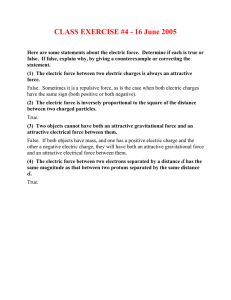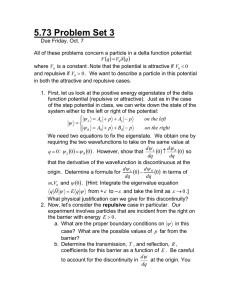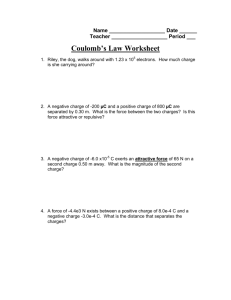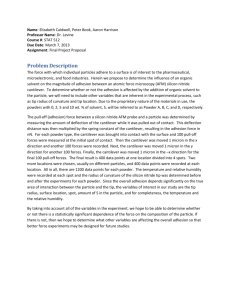3.052 SAMPLE PROBLEMS FROM PREVIOUS YEARS 1.
advertisement
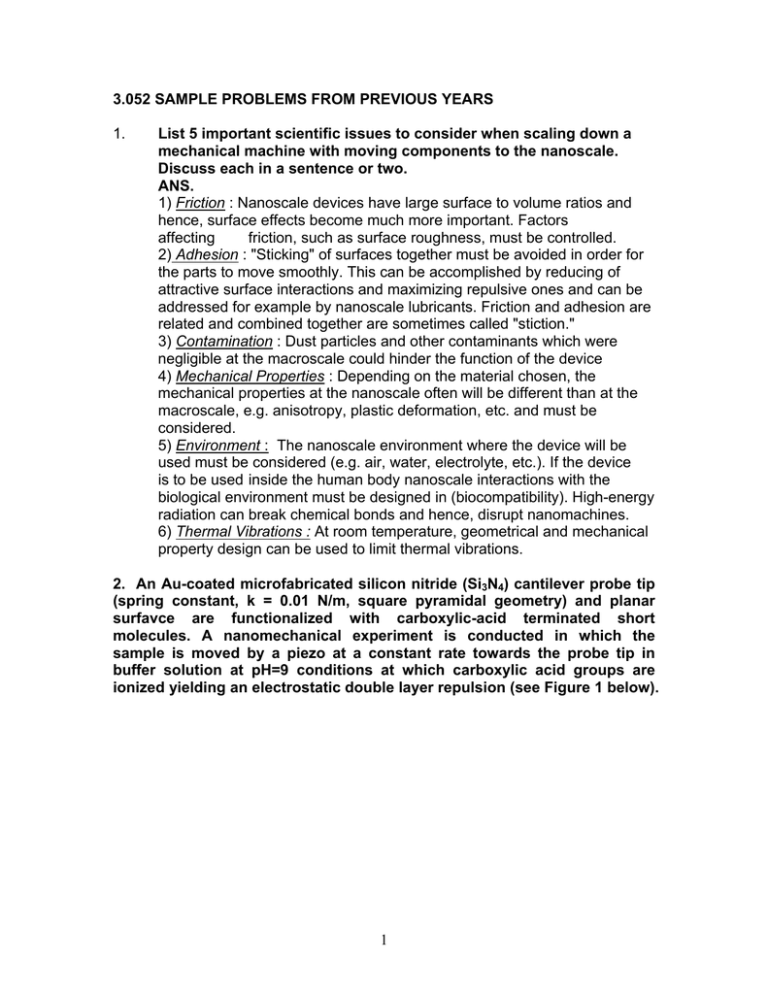
3.052 SAMPLE PROBLEMS FROM PREVIOUS YEARS 1. List 5 important scientific issues to consider when scaling down a mechanical machine with moving components to the nanoscale. Discuss each in a sentence or two. ANS. 1) Friction : Nanoscale devices have large surface to volume ratios and hence, surface effects become much more important. Factors affecting friction, such as surface roughness, must be controlled. 2) Adhesion : "Sticking" of surfaces together must be avoided in order for the parts to move smoothly. This can be accomplished by reducing of attractive surface interactions and maximizing repulsive ones and can be addressed for example by nanoscale lubricants. Friction and adhesion are related and combined together are sometimes called "stiction." 3) Contamination : Dust particles and other contaminants which were negligible at the macroscale could hinder the function of the device 4) Mechanical Properties : Depending on the material chosen, the mechanical properties at the nanoscale often will be different than at the macroscale, e.g. anisotropy, plastic deformation, etc. and must be considered. 5) Environment : The nanoscale environment where the device will be used must be considered (e.g. air, water, electrolyte, etc.). If the device is to be used inside the human body nanoscale interactions with the biological environment must be designed in (biocompatibility). High-energy radiation can break chemical bonds and hence, disrupt nanomachines. 6) Thermal Vibrations : At room temperature, geometrical and mechanical property design can be used to limit thermal vibrations. 2. An Au-coated microfabricated silicon nitride (Si3N4) cantilever probe tip (spring constant, k = 0.01 N/m, square pyramidal geometry) and planar surfavce are functionalized with carboxylic-acid terminated short molecules. A nanomechanical experiment is conducted in which the sample is moved by a piezo at a constant rate towards the probe tip in buffer solution at pH=9 conditions at which carboxylic acid groups are ionized yielding an electrostatic double layer repulsion (see Figure 1 below). 1 10 probe tip COOH probe tip versus COOH surface average D O electrostatic repulsion O O C Force/Radius (mN/m) C O 8 0.5 COOH probe tip versus COOH surface standard deviation 6 0.3 4 Force (nN) cantilever 2 0.1 0 0 5 10 15 20 -2 sample -0.1 Tip-Sample Separation Distance, D (nm) Figure 1. Chemical force spectroscopy experiment taken using a nanomechanical instrument called a 1-Dimensional Molecular Force Probe (Asylum Research, Inc.); "radius" on the y-axis is the probe tip end-radius, positive values of force indicate repulsion. (a) At a tip-sample separation distance of 3 nm how much does the cantilever defect upwards? ANS. Reading off the plot above, at D = 3 nm the Force, F =0.14 nN. Using Hooke's Law to represent the behavior of the cantilever: F = kδ 0.14nN F = = 14nm k 0.01N / m where is the cantilever deflection. 2 pts (b) At D=0, estimate how many molecules are feeling the repulsive force on the probe tip if the area per molecule, Amolecule ~ 0.216 nm2 (*hints : approximate the probe tip geometry simply and take into account the maximum range of the repulsive interaction) 3 pts ANS. The probe tip geometry can be approximated as a hemisphere (Figure A1.) At D = 0 the surface area of the probe tip which feels the repulsive force (ATIP) is shown in blue. The geometrical parameters are defined as follows: D is the probe tip-substrate separation distance = 0, DMAX is the maximum tip-sample separation distance range of interaction) ~ 5 nm from Figure 1, and RTIP is the probe tip radius which is determined from the Force/Radius axis of the plot above to be = 63 nm. ATIP is the surface area of a portion of a sphere which is defined as: δ= A TIP = π R TIP D MAX = π ( 63nm )(15 nm ) = 2967 nm 2 The number of molecules that can fit in this surface area is : No. Molecules = ATIP Amolecule 2 2967 nm 2 = = 13, 747 0.216 nm 2 RTIP probe tip DMAX ATIP D=0 substrate Figure A1. (c) What could be the reason for the apparent infinite slope of the curve at D=0? 2 pts ANS. The apparently infinite slope at D=0 indicates that the surface below the molecules is much stiffer than the transducer. (d) Schematically draw how you would expect the force versus tipsample separation distance plot above to change if the surface was a carboxylic acid end-functionalized polymer that is end-tethered to the surface (Figure 2) with a height of ~ 10 nm. Indicate the correct approximate distance range at which the forces are felt and explain in a few sentences the molecular origin of this change. 2 pts O O C 10 nm Figure 2. ANS. Upon approaching the surface, the electrostatic repulsion will still be felt at 15 nm from the carboxylic acid head groups at the top of the polymer layer. An additional 10 nm of repulsion will take place due to entropic compression of the polymer chain. Hence, the maximum distance range will be : D MAX = Delectrostatic + D polymer = 15 nm + 10 nm = 25 nm 3 COOH probe tip versus COOH surface average 8 0.5 COOH probe tip versus COOH surface standard deviation 6 polymer surface 0.3 4 Force (nN) Force/Radius (mN/m) 10 2 0.1 0 0 5 10 15 20 -2 -0.1 Tip-Sample Separation Distance, D (nm) Hence, The curve will shift to the right by approximately 10 nm. 1. Use the following paper as a reference: "Probing Intermolecular Forces and Potentials with Magnetic Feedback Chemical Force Microscopy," Paul D. Ashby, Liwei Chen, and Charles M. Lieber, 9467 J. Am. Chem. Soc. 2000, 122, 9467-9472 (posted on the course website). a. Digitize and plot the data of Figure 5 (feel free to use software such as FindGraph, a 30 day trial version can be downloaded from here: http://www.uniphiz.com/findgraph.htm) which is a high resolution force spectroscopy experiment between two hydroxylterminated self-assembling monolayers. A. 4 Digitized Data 1 0.8 0.6 0.4 0.2 0 0 1 2 3 4 5 6 7 8 Approach Retract -0.2 -0.4 -0.6 -0.8 -1 D (nm) b. Fit the data to an appropriate van der Waals interaction function (approach and retract separately) and show the fits on your plot. A. For this part, we focus on the attractive regime of the curves - between D=1.5 nm and D=8 nm - only. We can model the interaction between the AFM tip and the sample surface as an interaction between a sphere and a surface. From the Lecture #14 Supplement, the van der Waals interaction potential between a sphere and a flat surface is: WSPH-SFC(D)=-AR/6D where A is the Hamaker constant, R is the radius of the sphere (which is 75nm according to the Ashby paper), and D is the separation distance between the sphere and the surface. The van der Waals interaction force is calculated by taking the derivative of the potential with respect to D: FSPH-SFC(D) = -dWSPH-SFC(D)/dD FSPH-SFC(D) = -AR/6D2 One way to fit the digitized data to an appropriate van der Waals interaction function is to re-plot the data points in the attractive regime as F vs. R/6D2. A linear trend-line of the data plotted in this manner will have a slope equal to the Hamaker constant. 5 Attraction Regime Only 0 0 1 2 3 4 5 6 -0.1 -0.2 Approach -0.3 y = -0.0976x - 0.022 -0.4 Retract Linear (Retract) Linear (Approach) -0.5 -0.6 -0.7 -0.8 -0.9 y = -0.1782x + 0.0238 -1 R/6D^2 (1/nm) c. From these datafits, estimate the Hamaker constant for the approach and retract curves separately. A. Reading off the slopes of the formulas for the above trend-lines: Approach: A = 0.0976 nN*nm = 9.76 x 10-20 J Retract: A = 0.1782 nN*nm = 1.782 x 10-19 J d. How do these values compare to typical values for metals, ceramics, and polymers? A. From the Lecture #14, Supplement #2: Metals 3.0-5.0 x 10-19 Alumina 1.40 x 10-19 MICA 1.35 x 10-19 PVC 7.8 x 10-20 Hydrocarbons 5.0 x 10-20 2. The data of Fig. 13.13 in Israelachvili is a surface force apparatus experiment between two lipid monolayers. At higher temperatures, the interaction is suggested to be primarily dominated by hydrophobic interactions. Digitize or manually measure this data, plot, and fit to an appropriate van der Waals function to calculate a Hamaker constant. Does the Hamaker constant value support this hypothesis? Problem 2. Digitize the data at 37°C , as shown below, interaction force between the two plates is zero at long distance, thus, the force curve need to be shifted to zero the force at longer distance ( > 6nm in this case). 6 0.4 0.2 Raw Data F/R (mN·m-1) 0 -0.2 Shifted Data -0.4 -0.6 -0.8 -1 0 2 4 6 8 Distance (nm) −2 Plug in the fact R = 1cm = 10 m , fit the force in attraction region with Van der waals AR interactions, F = − , as shown below. 6D 2 x=-R/6D2 (nm-2) 0 0.0002 0.0004 0.0006 0 -0.002 F(mN) -0.004 -0.006 -0.008 F = -16.835x + 0.0004 -0.01 R is observed, this indicates that van der Waals 6D 2 interactions is not the only dominant effect in this experiment. In addition, the linear fit yields a Hamaker constant A = 16.8mN ⋅ nm 2 = 1.68 × 10 −20 J = 16.8 zJ , greater than the Hamaker constant of hexadecane in water = 5zJ (Israelachvili). Hence, this experiment suggests hydrophobic interactions are present. No linear dependence of F and − 3. Is it possible to measure the attractive adhesion force due to dispersive van der Waals interactions in an atomic force 7 spectroscopy experiment conducted in vacuum or air with a Si3N4 cantilever and probe tip on a flat surface at a tip-sample separation distance, D=10 nm? (HINT: model the AFM probe tip as a sphere with a radius equal to the tip radius of curvature, Rtip≈50 nm and assume the Hamaker constant, A≈10-19J). A. To calculate the attractive adhesion force due to dispersive van der Waals interactions, refer to page 177 of Israelachvili (or Lecture Notes #13) where the dispersion interaction energy between a sphere and surface is defined as follows: WSPH-SFC(D)=-AR/6D The dispersion interaction force is calculated by taking the derivative of the energy with respect to D: FSPH-SFC(D) = -dWSPH-SFC(D)/dD FSPH-SFC(D) = -AR/6D2 Substituting in the given numerical values : FSPH-SFC (D=10 nm) = (10-19 Nm • 50•1E-9 m) /6(10•1E-9 m)2 FSPH-SFC (D=10 nm) = 8.3 pN From problem set #1, the force detection limit of the AFM is determined by thermal oscillations of the force transducer,<Fm2>1/2. If we assume it behaves as a one-dimensional, free, undamped harmonic oscillator then <Fm2>1/2 = √(k BTk ). Since the minimum k = 0.01 N/m, <Fm2>1/2 = 6.4 pN. Therefore, yes, it is possible since FSPH-SFC (D=10 nm) > <Fm2>1/2. 4. Q. Short Answer Questions (*please answer with a few sentences): (a) Two parallel, nonpolar polymers are a distance r apart, as the size of the monomer unit increases, does the attractive dispersive van der Waals interaction increase or decrease? A. From p. 177 Israelachvili and the Lecture #14 Supplement, w(r)=-3πAL/8σ2r5 where σ is a parameter which describes the size of a monomer unit. Hence, it decreases. (b) What is the difference between the rupture force and the adhesion force? A. The rupture force is the force necessary to break the interaction between individual atoms or molecules. The adhesion force is the force needed to break the interaction between bodies containing many atoms or molecules, e.g. particles, surfaces, etc. 8 (c) The interaction potential between bodies is a function of what three physical parameters? A. (1) geometry of the experiment (2) size of the bodies (2) Hamaker constant or interactomic / intermolecular potential (d) Name five applications where interparticle interactions are critical. A. (1) biocompatibility of implant surfaces (2) pharmaceutical powder blending (3) paints (4) AFM probe tip-surface interactions (5) metallographic polishing fluids 1. Q. Consider the approach of two individual phenol molecules (C6H5OH) in a high-resolution force spectroscopy experiment conducted at room temperature in air as shown in the Figure below. Assume the phenol molecules interact as freely rotating permanent dipoles (dipole moment, μ=1.5 D (Debye) where 1D=3.336*10-30 C•m) which (besides attraction) undergo a steric, soft, power law repulsion (repulsive interaction parameter, B=10-135 Jm12, repulsive interaction exponent, m=12). (a) Neglecting VDW dispersion forces, Plot U(r) (kBT) and F(r) (nN) for r<1.0 B nm on separate graphs and label ro (nm), re(nm), rs(nm), Umin(kBT), and Frupture(nN) on the graphs. B spring k=0.1 N/m intermolecular interaction phenol molecule attached to probe tip phenol surface A. (a) The total intermolecular interaction energy, U(r), is a summation of the attractive and repulsive components of the potential : 9 U(r) = Uattractive(r)+Urepulsive(r) For freely rotating permanent dipoles, the attractive component is defined as follows (Israelachvili, page 28) : Uattractive(r)=-(μ12μ22/3kBT(4πεo)2)r6 (1) B where : μ1 and μ2 are the dipole moments of the two interacting molecules (for this problem μ1=μ2=μ=1.5 D (Debye) where 1D=3.336*10-30 C•m), εo is the dielectric permittivity of free space=8.854*10-12 C2 J-1m-1, and kBT is the thermal energy at room temperature= 4.1*10-21 J. B The steric, soft, power law repulsion (Israelachvili, page 112) : Urepulsive (r)=+B/rm where : the repulsive interaction parameter is given as B=10-135 Jm12 and the repulsive interaction exponent, m=12. The force curve is given by : F(r)=-dU(r)/dr 10 11 re ro rs 1 U(r)(kBT) 0.5 Uattractive 0 0 -0.5 0.2 0.4 0.6 0.8 1 0.8 1 Utotal -1 Umin=EB Urepulsive -1.5 0.05 0.04 F(r)(nN) 0.03 0.02 0.01 0 -0.01 0 0.2 0.4 0.6 -0.02 -0.03 Frupture -0.04 -0.05 r (nm) 12 (b) The spring will exhibit a linear mechanical instability when |dF/dD|>|k|. Superimpose the spring instability curve on F(r) to determine the separation distance at which the jump-to-contact occurs and the separation distance range of lost data. 0.05 0.04 spring instability curve F(r)(nN) 0.03 0.02 0.01 0 -0.01 0 0.2 0.4 0.6 0.8 1 -0.02 -0.03 -0.04 -0.05 region of lost data k=0.1 N/m r(nm) The jump-to-contact occurs at ~ r=0.45 nm. The region of lost data takes place from ~ r=0.29 nm to r=0.45 nm. (c) If one was to include a power law VDW dispersion interaction in the calculation of the total intermolecular interaction, how would the binding energy change (interaction constant, A=10-77 Jm6, interaction exponent, n=6)? A. We need to add one more attraction term to equation (1) : Uattractive(r)=-(μ12μ22/3kBT(4πεo)2)r6 -A/rn B 13 5 U(r)(kBT) 0 0 0.2 0.4 0.6 0.8 1 -5 -10 -15 The binding energy increases to EB=13kBT. B 2. Q. It is often argued that the Lennard-Jones potential is applicable to chemical bonds as well as physical bonds, where the attractive van der Waals part remains unchanged and where only a difference in the repulsive coefficient, B, distinguishes between the two types of interaction. If A=10-77 Jm6 and the equilibrium separation is at re=0.35 nm for physical bonding and re=0.15 nm for chemical bonding, assume that the above stated hypothesis is true and calculate the binding energy EB=wmin from each case and argue whether or not the result tends to support the above view. B A. Given : A=10-77 Jm6, re(physical)=0.35 nm, re(chemical)=0.15 nm re=[2B/A]1/6 (page 9, Israelachivili) ⇒ B=A[re]6/2 Physical Bonds : B=10-77 Jm6• [0.35•1E-9 (m)] 6/2=0.919•1E-134 Jm12 Chemical Bonds : B=10-77 Jm6• [0.15•1E-9 (m)] 6/2=5.695•1E-137 Jm12 wmin=-[A2/4B] (page 9, Israelachivili) wmin(physical)=-[10-77(Jm6)]2/(4•0.919•1E-134 Jm12) 4.1*10-21J/kBT=0.66kBT wmin(chemical)=-[10-77(Jm6)]2/(4•5.695•1E-137 Jm12) 4.1*10-21J/kBT=107kBT B Yes, since the bond strength of covalent bonds range from 100-800kBT. B 14 3. Short Answer Questions. (a) Q. Why does ice float on water? A. Water has a higher density because when ice crystallizes it packs into a more open, H-bonded structure (see Israelachvili page 122-125). (b) Q. What is a possible reason for the low melting point, Tm, of many traditional polymers? A. Tm is controlled by weak, intermolecular dispersion interactions between neighboring polymers chains. (c) Q. What is the primary controlling intermolecular interaction for the following polymers in the solid state : (1) poly(urethane) (2) poly(vinyl chloride) (3) poly(styrene) A. (1) H-bonding or dipole-dipole (2) H-bonding or dipole-dipole (3) dispersion (d) A -CH3 functionalized AFM probe tip is brought into contact with a -CH3 functionalized surface in water and the adhesion force is observed to be much greater than that expected for purely dispersive interactions, why? A. -CH3 groups are strongly hydrophobic and prefer to stick together. (e) Two surfaces exhibit a strong adhesion in water but not in cyclohexane or benzene, why? A. The surfaces are hydrophobic in water which is polar. The effect is eliminated when dissolved in a nonpolar solvent such as cyclohexane or benzene. Q. The limit of force detection for a particular AFM cantilever is 10 pN. Is it possible to measure the attractive force due to dispersive van der Waals interactions in an atomic force spectroscopy experiment conducted in vacuum or air with a Si3N4 cantilever and probe tip (Rtip ≈50 nm) on a flat surface at a tip-sample separation distance, D=10 nm ? You many assume the Hamaker constant, A≈10-19J. A. To calculate the attractive adhesion force due to dispersive van der Waals interactions, refer to page 177 of Israelachvili where the dispersion interaction energy between a sphere and surface is defined as follows: W(D)=-AR/6D The dispersion interaction force is calculated by taking the derivative of the energy with respect to D : F(D)=-dW(D)/dD 15 F(D)=-AR/6D2 Substituting in the given numerical values : F(D=10 nm)=(10-19 Nm • 50•1E-9 m) /6(10•1E-9 m)2 F(D=10 nm)=8.3 pN No you could not measure it. 2. Q. Derive an equation for the interaction force between a charged molecule and a surface consisting of freely rotating dipolar molecules as a function of separation distance, D. A. The interaction potential between a molecule and a surface is derived on page 156 of Israelachvili (or Lecture #6) as equation (10.1) : W(D)=[2πAρ]/[(n-2)(n-3)Dn-3] This is assuming an intermolecular pair potential of the following form: w(r)=-A/rn Substituting n=4 for the charge-freely rotating dipole interaction (page 28, Israelachvili) into W(D) one obtains : W(D)=[2πAρ]/[(4-2)(4-3)D4-3] W(D)=[2πAρ]/[2D] Then, one can take the derivative of the energy with respect to D to obtain the force : F(D)=-dW/dD=-[2πAρ]/[2D2] (a) Explain in words what the Hamaker constant is. A. The Hamaker constant is the strength of the molecular level interatomic or intermolecular interaction multiplied by the density (A=Aπ2ρ2). (c) Define adhesion hysteresis and what causes it. A. Adhesion hysteresis is when the adhesion force on retract is greater than the jump-tocontact force and is caused by time-dependent structural rearrangements of the surface, polymeric diffusion across the interface, water condensation due to additional capillary forces, etc. 16 (d) Can you ever get an attractive force between two charged surfaces (with no other attractive interactions acting) and why? A. Yes if the two surfaces are oppositely charged. (e) Explain what a contact area is. A. It is the interaction area between two surfaces under an external compressive load or due to surface adhesion forces. 1. Q. Name three differences between Nanomechanics and Macromechanics. A. NANOMECHANICS MACROMECHANICS size scale probed~nanometer, size scale probed~millimeter e.g. single molecules e.g. many molecules force range probed ~nanonewton force range probed ~ newton details of chemical structure important in details of chemical structure ignored many cases in many cases experimental techniques used : atomic force experimental techniques used : bulk microscopy, optical tweezers, surface force mechanical testing apparatus surfaces important bulk properties important mechanical properties size-dependent mechanical properties independent of size (a) Would you expect an attractive or repulsive force to be present between two hydrophilic surfaces in aqueous solution? A. repulsive, so that they can maximize their exposure to water (this is the opposite of the hydrophobic attractive force) (b) Would you expect hydrophobic forces to be present in organic solvents? A. No! The origin of the attractive hydrophobic force is due to the avoidance of water. (c) The attractive van der Waals dispersion force ~α2 where : α is the polarizability of the e- cloud. Explain this. A. As the electron cloud is more easily distorted, the strength of the fluctuating dipoles increases and hence, the attractive force increases. (d) What is the difference between polar interactions and polarization interactions? A. Polar interactions are between an ion and a permanent dipole or two permanent dipoles. Polarization interactions are between charge-nonpolar (induced or instantaneous dipole) dipole-nonpolar (induced dipole). . 17 (e) Name any three requirements for studying the elasticity of individual macromolecules. A. low surface grafting density, the ability to tether two ends of a chain, small probe tip (Rtip≈RF), a soft cantilever, i.e. a cantilever spring constant comprable to the the global chain stiffess (kcantilever ≈kchain) (f) Explain the difference between contact and surface forces in materials science, i.e. what is the molecular origin of each? Which one would you use a soft cantilever (low k) and which one a stiff cantilever (high k)? A. contact forces are described by the Herzian theory and originate from linear elastic deformation of a body, i.e. compressing of covalent and noncovalent bonds within a material, you would use a high k cantilever because contact forces are relatively strong surface forces originate from noncovalent interactions, surface roughness and mechanical interlocking, capillary forces due to water condensation, diffusion of polymers chains across interfaces, etc. and result in adhesion, you would use a low k cantilever because surface forces are relatively weak 1. The retraction data from an atomic force spectroscopy experiment is shown in the figure below (*assume that D>>Rtip=15 nm and the Hamaker constant=10-19J) . • • 0 • • ••• • ••• ••• • ••• • • • • • • • • • •••• • III. •• • Force, F (nN) • I. F~D-4 •• • II. 0 Tip-Sample Separation Distance, D (nm) (a) Q. In what region and how would the force curve change as one uses increasingly softer cantilevers for this experiment, assuming that kcantilever still remains<< ksample ? (*show schematically or describe in words) A. Since the slope of the cantilever instability (region II) is equal to the cantilever spring constant, the distance range of the cantilever instability and region of lost data would be increased upon using softer cantilevers. (b) Q. At what distance has the interaction energy become comparable to the thermal energy at room temperature ? A. Let F=-C/D2 where C is a constant, then the net interaction energy is : 18 W(D)=-∫F(D)dD=-∫-C/D4dD=-C/D3~1/D3 (1) If the atomic force spectroscopy experiment is modeled as a sphere interacting with a surface for D>>Rtip: WSPHERE-SFC(D)=-8π2Aρ2Rtip3/3(n-2)(n-3)Dn-3~1/Dn-3 (2) Comparing eqs. (1) and (2), we find that the molecular interaction exponent, n=6. Substituting n=6 into equation (2) we obtain: WSPHERE-SFC(D)=-8π2Aρ2Rtip3/3(6-2)(6-3)D6-3=-2ΑRtip3/9D3 (3) where : A is the Hamaker constant. Setting equation (3) equal to the thermal energy, kBT : B W(D)=-2ΑRtip3/9D3 = -kBT (4) Rearranging equation (4) to solve for D and substituting in appropriate numerical values : D=3√(2ARtip3)/(9•kBT)= 3√(10-19J•153 nm3)/(3•4.1•10-21J)= 26.3 nm (2) Q. A carbon nanotube is attached to the end of the cantilever / probe tip to which is attached a single positively charged protein molecule. A HRFS experiment is conducted on a planar surface consists of freely rotating, permanent dipoles. The cantilever/probe tip pulls off the surface at F=3 nN and D=1 nm. How much of the force is due to purely electrostatic interactions and how much is due to dispersion interactions (Adispersion=10-77 J m6, Acharge-freely-59 Jm4)? rotating dipole=2.5 *10 A. The interaction potential between a molecule and a planar surface is : WMOL-SFC(D)=-[2πAρ]/[(n-2)(n-3)Dn-3] This is assuming an intermolecular pair potential of the following form: w(r)=-A/rn Substituting n=4 for the charge-freely rotating dipole interaction (page 28, Israelachvili) into W(D) and taking the derivative with respect to D to obtain the force one obtains : W(D)charge-dipole=-[πAcharge-dipole ρ]/D F(D)charge-dipole =-dW(D)/dD=-[πAcharge-dipoleρ]/D2 (1) 19 Substituting n=6 for the dispersion interaction (page 28, Israelachvili) into W(D) and taking the derivative with respect to D to obtain the force one obtains : W(D)dispersion=-[πAdispersionρ]/[6D3] F(D)dispersion=-[πAdispersionρ]/[2D4] (2) The ratio of the purely electrostatic to dispersion force is [equation (1) / equation (2)]: F(D)charge-dipole/F(D)dispersion = [Acharge-dipole/Adispersion]2D2 Substituting A values in and D=1 nm : F(D)charge-dipole/F(D)dispersion=[2.5•10-59 Jm4•2•(1*1E-9m)2]/10-77 Jm6=5 (3) The adhesion force is the sum of the dispersion and purely electrostatic interactions : Fadhesion(D=1nm)= -3 nN= F(D)charge-dipole+F(D)dispersion (4) Equations (3) and (4) give us two equations and two unknowns : F(D)dispersion = -0.5 nN F(D)charge-dipole = -4.5 nN Energy (kBT) 3. Draw a schematic of a typical interatomic potential, U (kBT), versus separation distance, r (nm), for an ionic bond (charge-charge) in water including the magnitude of the energy and distance at the equilibrium bond length. 0 0 Separation Distance, r (nm) 20 A. Draw an asymmetric potential with EB≈5 kBT and re =0.25 nm. 4. Short Answer (*answers shouldn't be more than a few lines). (a) Q. Would you expect the polymer film shown in the figure below to be poly(methacrylic acid)(PMAA) or poly(acrylic acid) (PAA) and why? n n CH3 O OH PMAA O OH air H2 0 po ly m er film PAA A. Since the H20 is shown to spread along or wet the polymer film, it has favorable interactions with H20 and hence, is hydrophilic. Both polymers have hydrophilic –-COOH groups which can form H-bonds, but the PMAA also has hydrophobic methyl groups as well. Hence, one would it expect the polymer shown to be PAA. (b) Q. Draw a schematic of the interatomic potential between two nonpolar atoms using a hard-sphere repulsion rather than a soft (power-law) repulsion. A. w(r)=-A/rn+B/rm where n=6, m=∞ repulsion~rm, m⇒∞ w(r) dispersion~r-6 r (c) Q. Explain why poly(ethylene oxide), -[CH2-CH2-O]n- is hydrophilic and soluble in water. A. The polymer chain can H-bond via the oxygen (δ-) to the hydrogens (δ+) in H20. (d) Q. What are the molecular origins of the two terms in the Lennard-Jones potential? A. attractive van der Waals-dispersion interactions and steric repulsion due to overlap of electron clouds 21 (e) Q. In an AFM force spectroscopy experiment what happens at the adhesion force ? A. The force transducer (e.g. cantilever) suddenly detaches off the sample surface. 2. The data from an atomic force spectroscopy experiment conducted in aqueous salt solution is shown in the figure below. The forces operating are dispersion van der Waals forces and long-range electrostatic repulsive forces (*assume the Hamaker constant=10-19J, Rtip=30 nm, D<<Rtip). You may neglect short-range, repulsive atomic steric forces. (a) Calculate the Debye Length with a short explanation of your calculations included (you may assume that electrostatic forces dominate the interaction for D>3 nm). (b) For this sample, the solution salt concentration is varied so that the Debye length is 1 nm. Calculate the magnitude of the force at D=0.5 nm. (c) Using the Derjaguin approximations for dispersion interactions, calculate the magnitude of the attractive dispersion component of the force if the experiment was conducted between two spheres both with radius=5nm. 3 Force (nN) 2 1 0 -1 0 1 2 3 4 -2 -3 Distance (nm) 3. Short Answer Questions (please answer in one or a few sentences). (a) 22 5 F1=Aexp(-κD1) F2=Aexp(-κD2) A. The following equation is for the DMT theory : F(D)=AD3/2-Fadhesion where : A=K√R Fadhesion can be read directly off the graph and equals 1.83 nN. The DMT theory is expected to hold for small D. Hence, choose one experimental datapoint for relatively small D to determine A (e.g. F1=0 nN, D1=10 nm) : 23 F1=AD13/2-1.83 A=(F1+1.83)/D13/2 A=(0+1.83)/103/2 A=0.04 nN nm-3/2 calculate the magnitude of the repulsive component of the force at D=1 nm (b) What is the magnitude of the repulsive force needed to make the system unstable (purely attractive) at D=1 nm? (c) *Using the Derjaguin approximations for dispersion interactions*, calculate the magnitude of the attractive dispersion component of the force if the experiment was conducted between two spheres both with radius=5nm. A. (a) WSPHERE-SFC(D)= =-4π2Aρ2R/(n-2)(n-3)(n-4)(n-5)Dn-5 (D<<R) for attractive dispersion interactions, n=6, and the Hamaker constant is A=Aπ2ρ2: Wdispersion(D)=-ARtip/6D (D<<R) Fdispersion (D)=-dW(D)/dD=-ARtip/6D2 Fdispersion(D=1 nm)=-(10-19 J•30•10-9m)/6(1•10-9m)2 =-0.5 nN FTOTAL=Fdispersion+Frepulsive= -0.5 nN + Frepulsive=+2 nN (*read off from graph above) Frepulsive=+2.5 nN (b) FTOTAL=Fdispersion+Frepulsive= -0.5 nN + Frepulsive=0 nN Frepulsive≤+0.5 nN (c) The Derjaguin approximations for dispersion interactions give : FSPHERE-SFC(D)=2πRWPLANES(D) FSPHERE-SFC(D=1 nm)=-0.5 nN=2πRWPLANES(D=1nm) WPLANES(D=1 nm)=-0.5 nN/2π(30 nm)=-2.65•10-3N/m FSPHERE-SPHERE(D)=2π(R1R2/R1+R2)WPLANES(D) R1=R2=R=5nm 24 FSPHERE-SPHERE(D=1 nm)=πRWPLANES(D=1nm)= π•5 nm•-2.65•10-3N/m=-0.0416 nN This can be checked by : Wdispersion(D)=-ARtip/12D (D<<R) Fdispersion (D)=-dW(D)/dD=-ARtip/12D2 Fdispersion(D=1 nm)=-(10-19 J•5•10-9m)/12(1•10-9m)2 =-0.04166 nN 3. Short Answer Questions (*answers shouldn't be more than a few lines). (a) Q. In an AFM experiment the adhesion force is measured to be 3 nN. If the z-piezo deflection is 10 nm and the cantilever spring constant is 1 N/m what is the tip-sample separation distance, D? A. The cantilever behaves as a linear elastic Hookean spring (F=kδ)-hence, the cantilever displacement is δ=F/k=-3 nN/1 N/m=-3nm. The tip-sample separation distance is : D=z+δ=10 nm-3 nm=7nm (b) Would you expect an attractive or repulsive force to be present between two hydrophilic surfaces in aqueous solution? A. repulsive, so that they can maximize their exposure to water (this is the opposite of the hydrophobic attractive force) (c) Would you expect hydrophobic forces to be present in organic solvents? A. No! The origin of the attractive hydrophobic force is due to the avoidance of water. (d) The attractive van der Waals dispersion force ~α2 where : α is the polarizability of the e- cloud. Explain this. A. As the electron cloud is more easily distorted, the strength of the fluctuating dipoles increases and hence, the attractive force increases. (e) What is the difference between polar interactions and polarization interactions? A. Polar interactions are between an ion and a permanent dipole or two permanent dipoles. Polarization interactions are between charge-nonpolar (induced or instantaneous dipole) dipole-nonpolar (induced dipole). 25
